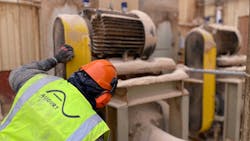The foundation for artificial intelligence and the next steps for manufacturing
Here, in the Fourth Industrial Revolution, on the cusp of Industry 5.0, manufacturing has built fast and far upon early automation. Initial digitization efforts focused on developing dedicated software unique to each manufacturer, which required deep resources. The movement toward more generalized software applications, made possible by cloud computing, has helped move the needle toward the application of artificial intelligence (AI) in manufacturing operations.
“What has enabled the Fourth Industrial Revolution is increasing integration of software into manufacturing processes, and increasing connectivity and interoperability between software systems,” says Artem Kroupenev, vice president of strategy at Augury, an Industrial AI technology company, offering software and hardware as a service to optimize the health of machines, processes and production. “Large IT departments were established to connect, integrate, and manage disparate and unique legacy production systems into enterprise-level, generalized software systems, and this work is ongoing today.”
Many waves of technological evolution have influenced where manufacturing is today on the digital journey. In the beginning, automation was analog, and as software came into digital maturity, it allowed dedicated code for specific machines. Then, software development became more generalized, operating entire systems – think enterprise resource planning (ERP) or enterprise asset management (EAM) systems. This also meant companies had developed entire IT departments to create these systems, working with operational technology departments trying to connect all the pieces.
In large part, cloud computing helped centralize all those pieces and the development of software itself. This connected world of data and devices, combined with massive computing power, has laid the foundation for artificial intelligence to change the landscape again. “This proliferation of data, cloud, a lot of computing power, and the centralization of software development, that's a ripe, fertile ground for AI applications,” Kroupenev says.
The Fifth Industrial Revolution will be dominated by AI, the next major technology evolution, and no one can predict for sure what AI will create long-term. The necessary components for AI-enhanced production and manufacturing—lots of data and computing power—are also only useful with an artificial intelligence. “You have to have something beyond human capacity to make sense of it all,” Kroupenev says.
AI in the future: copiloting decision-making
Many applications are already experimenting with and applying AI in their manufacturing operations, and many, like Kroupenev, are predicting that number will grow rapidly. “Is AI disrupting the manufacturing industry?” he asks. “What AI is actually doing is disrupting and improving software within the manufacturing industry.” That disruption is taking place already, but the key for AI, Kroupenev says, is what it will do for manufacturing in the future.
“Every function, every role within the main manufacturing space, is going to have a really useful copilot or system. It can have AI applications that enable them not just to do a certain task better or improve a certain aspect of their job, but really have a partner that improves a number of different parts of their jobs,” Kroupenev says.
The dynamic relationship between human and AI can be tremendously scalable, he adds, which means not only performing tasks faster, but also operating in partnership with AI in the decision-making process. Augury refers to this type of AI-enhanced operator system as a copilot, or a “hybrid intelligence of human intelligence combined with artificial augmented intelligence,” Kroupenev says. “We’re seeing the early development of that across manufacturing.”
AI’s time to scale
An army of maintenance professionals would still struggle to monitor every machine and piece of equipment, 24 hours a day, diagnosing and predicting failures ahead of time. AI can do that easily, understanding how machines fail and predicting those failures accurately, Kroupenev explains. “That’s humanly impossible, or that would require resources that no manufacturer will ever have,” he adds. While many operations already monitor equipment and asset conditions, artificial intelligence adds a cumulative and cultivating data analysis structure on top of predictive maintenance. Across large companies, AI can aggregate data from hundreds of thousands of pieces of equipment from facilities around the world.
Augury is seeing implementations of AI across almost every part of manufacturing, but Kroupenev points to predictive maintenance, and especially process engineering and optimization, as the first real scalable AI use cases. Supply chain optimization is also prime for AI enhancement and is one of the other areas being augmented by AI right now, Kroupenev says, for production scheduling, warehousing, and inventory management. There are also smaller pockets of growth for AI in areas like sustainability and energy efficiency and safety and compliance.
“The other thing I would say is that it builds up over the years as the technology develops,” Kroupenev says. “The earliest approaches of AI were really driven by answering, ‘do we have the underlying infrastructure, the data, and what can we do with that? Can we gather the right data? Can we then build some algorithms to solve a very specific use case?’,” Kroupenev says. That has evolved into more broadly based use cases.
Kroupenev outlines three types of problems manufacturers are solving with AI, the first being, classification. “How do I classify the problem effectively, so that I understand the root cause?” Kroupenev asks. Next, it can solve optimization problems. On a production line with hundreds of different dynamic parameters, AI can understand the whole system. Finally, the third type of problem-solving mechanism, takes the results of the first two, and adds predictive or generative abilities. “That’s generating something new that is based on existing knowledge,” Kroupenev says. “The ability to solve these three types of problems together is what’s really leading to a much broader application of AI. Before we were siloed and trying to solve for this one piece because we couldn’t see how it connected to the other pieces.”
Some facilities can perform this data work with in-house data science experts, but companies, like Augury, are also offering AI-as-a-service for those that need more third-party help or the full range of hardware products and software applications. For companies that don’t have that technical expertise, “this is where we’re seeing more and more of these core use cases really shine and scale across manufacturing,“ Kroupenev says. “All that work is taken off the plate from the customer and put into the hands of the provider or the vendor.”


